Pacific Northwest Trees
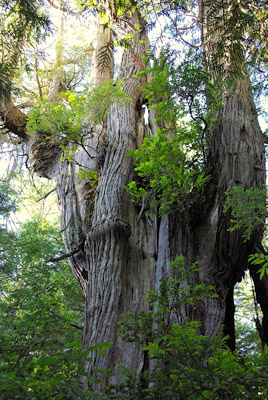
By Connor O'Malley
Pacific northwest trees are one of the most important resources to survival. They provide firewood, shelter, tools, food, medicine, wildlife habitat, and so much more to the ecosystem. If you know how to identify and use the trees in your local forest it will enhance your feelings of self-reliance and confidence in the outdoors. They are a great resource!
In this article I will share a few of the most common deciduous trees we see in the forests of western Washington and some of their survival, edible and medicinal uses. If you are interested in the common evergreen trees of Washington check out this great article: https://www.wildernesscollege.com/types-of-evergreen-trees.html .
Enjoy!
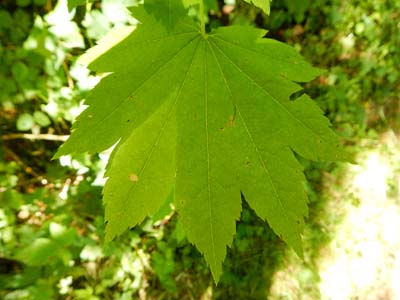
Vine maple: Acer circinatum
This common
maple is one of the most easily identified Pacific northwest trees by
its opposite branching, maple-like leaves, and green bark. It is our
most common “durable” wood that is strong in tension so it is ideal for a
wide variety of rugged projects. At Alderleaf we use vine maple for
bows, fish spears, trap parts, shelter construction and more. Native
Americans used vine maple for bows, tool handles, love medicine,
baskets, snow-shoes, house building, baby cradles, fish traps, acorn
paddles, small boxes, oil containers, bowls, drinking containers, and
salmon tongs. They also ate the sap and mixed the charcoal of vine
maple with oil and used it as a black paint. If you want to learn more
specifics about these Native American uses of Pacific northwest trees
such as how to make a love potion, you will have to do some research…
but it sure is interesting!
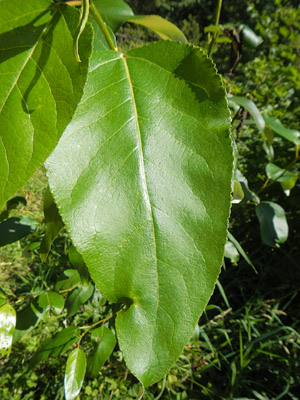
Black Cottonwood : Populus balsamifera ssp. trichocarpa
Generally,
deciduous Pacific northwest trees that grow near water are great woods
for friction fires. Black cottonwood is one of the best, especially the
roots. If you find an overturned cottonwood and the roots are exposed,
be sure to collect a few nice straight pieces for fireboards and
spindles. Conveniently, the dry inner bark of cottonwood makes
fantastic tinder. Black bears love to scrape off and eat fresh
cottonwood bark in the spring so keep an eye out for their sign!
Cottonwood
is brittle so it is not great for durable tools but it does have some
very important medicinal qualities. A salve from the buds is a great
pain reliever for arthritic joints, injuries, and tendinitis. The buds
hold the most potent medicine and a tincture of them makes a great
expectorant for congested chest colds.
You can make a salve from
any part of these Pacific northwest trees – buds, leaves, or bark. It
is great as a wound salve - reducing inflammation, encouraging healing,
eradicating bacteria and tightening surrounding tissue.

Red Alder: Alnus rubra
Alder
is one of the most common deciduous Pacific northwest trees. It has
smooth bark and serrated leaves. It is a “pioneer” species which means
it is one of the first to colonize a site that has been cleared or
disturbed. This is one of the reasons we chose Alder for the name of
Alderleaf Wilderness College! We strive to be a pioneer school that can
help people become better stewards of the earth.
Alder is a member of the birch family which means it ROTS.
It amazes me how fast birches decompose after they die. This benefits
an ecosystem in a variety of ways. Unfortunately this also means Alder
is a poor wood for tools or shelter building. It is however a decent
friction fire wood and it is great for burning in campfires. Because of
its abundance, we often cut live Alder and use it for quick survival
purposes.
Be More Prepared For Your Next Outdoor Adventure!
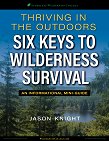
Don't leave home without knowing these six essential survival skills. Our free survival mini guide reveals the strategies of:
- Shelter & fire to prevent the number one cause of death
- Obtaining clean water to avoid life-threatening dehydration
- Common wild survival foods and other critical skills!

Native Americans used Red Alder for many things. They took a decoction of the bark as a purgative, applied the sap to cuts, chewed staminate aments for sores, rubbed the rotten wood on the body to ease “aching bones”, chewed the catkins for diarrhea, ate the fresh cambium with oil in the spring, used the wood to smoke fish and meat, boiled the bark and used it as a red dye, used the wood for carved dishes and canoe bailers, used the roots to make baskets, masks and rattles, canoe paddles, and they used the bark to line pots for storing elderberries!
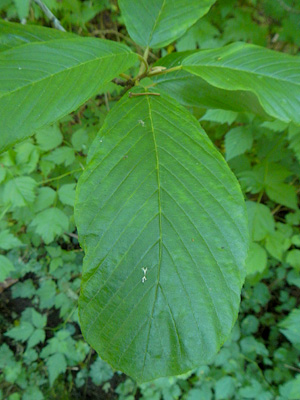
Cascara: Frangula purshiana
Cascara
is a little less common than these other trees but we still encounter
it quite frequently. It can be identified by its smooth waxy leaves,
smooth bark and long curved twigs. It is commonly known as a strong
laxative although I have never attempted to use it for this purpose.
The berries are considered poisonous but bears love to eat them.
Native
Americans were well aware of the medicinal properties in Cascara. An
infusion of bark was taken as a strong laxative, a poultice of the bark
was used for wounds, the fruit was considered poisonous, bark was chewed
by children with worms, an infusion of the foliage, twigs and bark was
taken as an emetic (to cause vomiting), the bark was mixed with crab
apple bark to prevent the crab apple from constipating the user, an
infusion of the spring bark was used as a disinfectant for cuts, wounds
and sores, an infusion of the bark was taken for gonorrhea, and the wood
was used to make implement handles – especially D-adze handles.
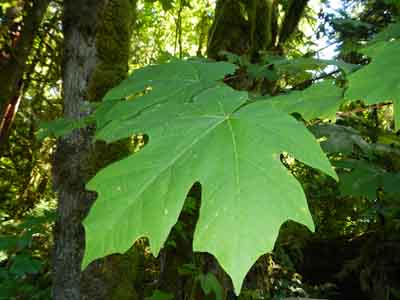
Bigleaf Maple: Acer macrophyllum
Bigleaf
maple is one of our most common deciduous Pacific northwest trees in
the forests of western Washington. They grow very large and are often
covered in moss – a beautiful sight to see and a classic image of
Washington. They have classic maple-like leaves, only bigger!
Bigleaf
maple is a great friction fire wood. The straight shoots can be used
for hand drill when dry and seasoned. Try them on a douglas fir
fireboard. The shoots also make great arrows.
Native Americans
used this tree for many things. An infusion of bark was taken for
tuberculosis, sticky bud gum and oil was used as a hair tonic, sap was
eaten dried and fresh, seeds were used for food, leaves were used in
steaming pits to flavor meat, cambium was eaten in small quantities with
oil, sap was boiled to make syrup, raw shoots were used for food, wood
was used for house construction, it was considered good firewood, wood
was used for canoe paddles, inner bark was used in spring for baskets,
bark was used to make crude dresses, bark was used for rope and
tumplines, and the leaves were made into mats and used to cover the
layers of dried salmon that were stored in baskets for the winter.
I
hope that was a helpful introduction to some of our most common
deciduous trees. If you are interested in any of the Native American
uses that I mentioned here please follow up with the sources I listed
and do further research to find out more specifics on how they prepared
the medicines and food. Good luck!
Knowing how to identify trees and knowing their uses is
one of the most important survival skills we teach in our Wilderness Certification Program. For me, I don’t really know a plant until I’ve used it for
something. That is why I love woodworking and survival skills. It
connects me to the Pacific Northwest trees because I get to know the
different quirks of each species. If you are interested in learning
more about the forest and these survival skills check out our course
calendar.
By the way, when you're out foraging, it's important to know how to stay safe in the outdoors, especially if you were to get lost. Right now you can get a free copy of our mini survival guide here, where you'll discover six key strategies for outdoor emergencies, plus often-overlooked survival tips.
Recommended Resources on Pacific Northwest Trees
Common Northwest Trees - Oregon State University
Ethnobotany of Western Washington by Erna Gunther
Plants Used by the Indians of Mendocino County, CA by V.K. Chestnut
Plants Used by the Hoh and Quileute Indians by Albert B. Reagan

Photo by Haley Brandt.
Related Courses:
Wilderness Survival Courses at Alderleaf
Wild Edible & Medicinal Plants Courses at Alderleaf

About the Author: Connor O'Malley is an experienced wilderness skills educator. He taught at Alderleaf for several years. Learn more about Connor O'Malley.
Return from Pacific Northwest Trees back to Wild Plants Articles
Is The Essential Wilderness Survival Skills Course Right for You? Take the "Online Survival Training Readiness" Quiz
See for yourself if this eye-opening course is a good fit for you. It takes just a few minutes! Get your Survival Training Readiness Score Now!

Grow Your Outdoor Skills! Get monthly updates on new wilderness skills, upcoming courses, and special opportunities. Join the free Alderleaf eNews and as a welcome gift you'll get a copy of our Mini Survival Guide.

 The Six Keys to Survival: Get a free copy of our survival mini-guide and monthly tips!
The Six Keys to Survival: Get a free copy of our survival mini-guide and monthly tips!
Learn more